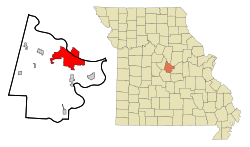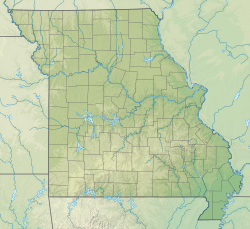
Back Jefferson City Afrikaans Jefferson City (Missouri) AN Gefersūnesburh (Misseōra) ANG جفرسون سيتي (ميزوري) Arabic چيفيرسون سيتى (ميزورى) ARZ Jefferson City (Missouri) AST Cefferson-Siti Azerbaijani جفرسونسیتی AZB Джэферсан-Сіці Byelorussian Джеферсън Сити Bulgarian
Jefferson City | |
|---|---|
 | |
| Nickname(s): Jeff City, JC, JCMO [1] | |
 | |
 U.S. Census Map | |
| Coordinates: 38°34′04″N 92°10′33″W / 38.56778°N 92.17583°W | |
| Country | |
| State | |
| Counties | |
| Founded | 1821 |
| Incorporated | 1825 |
| Named for | Thomas Jefferson |
| Government | |
| • Type | Mayor–council |
| • Mayor | Ron Fitzwater |
| • Administrator | Brian Crane |
| Area | |
| • State capital | 37.65 sq mi (97.51 km2) |
| • Land | 36.05 sq mi (93.38 km2) |
| • Water | 1.60 sq mi (4.13 km2) |
| Elevation | 630 ft (192 m) |
| Population (2020) | |
| • State capital | 43,228 |
| • Estimate (2023)[6] | 42,552 |
| • Density | 1,198.98/sq mi (462.93/km2) |
| • Metro | 149,807 |
| Demonym | Jefferson Citian |
| Time zone | UTC−6 (CST) |
| • Summer (DST) | UTC−5 (CDT) |
| ZIP codes | 65101-65111 |
| Area code | 573 |
| FIPS code | 29-37000[7] |
| GNIS ID | 758233[5] |
| Website | jeffersoncitymo.gov |
Jefferson City, informally Jeff City,[1] is the capital of the U.S. state of Missouri. It had a population of 43,228 at the 2020 census,[8] ranking as the 16th most populous city in the state.[9] It is also the county seat of Cole County and the principal city of the Jefferson City Metropolitan Statistical Area, the second-most-populous metropolitan area in Mid-Missouri and the fifth-largest in the state. Most of the city is in Cole County, with a small northern section extending into adjacent Callaway County.
Jefferson City is named for Thomas Jefferson (1743-1826), the third President of the United States, 1801-1809, and earlier major author of the Declaration of Independence of the United States on July 4, 1776. He also served several diplomatic posts overseas in Europe and was the first U.S. Secretary of State (1790-1793) in the first President's Cabinet of George Washington, and subsequently the second Vice President (1797-1801) under second chief executive John Adams.
Jefferson City is located on the northern edge of the Ozark Plateau on the southern side of the Missouri River in a region known as Mid-Missouri, that is roughly mid-way between the state's two large urban areas of Kansas City to the west and St. Louis in the east (along the west bank of the Mississippi River). It is 29 miles (47 km) south of Columbia, Missouri, and sits at the western edge of the Missouri Rhineland, one of the major wine-producing regions of the Midwest. The city is dominated by the monumental domed Missouri State Capitol, which rises from a bluff overlooking the nearby Missouri River to the north; Lewis and Clark with their Corps of Discovery passed the bluff here on their historic expedition upriver in 1804, eventually journeying westward to the Pacific Northwest region and the Pacific Ocean, before Europeans or Americans established any settlement there.
Many of Jefferson City's primary employers are in service and manufacturing industries. Jefferson City is also home to Lincoln University, a public historically black and federal land-grant university founded the year after the American Civil War in 1866, by the Union Army black veterans of the First Missouri Regiment of Colored Infantry & 62nd Regiment of U.S. Colored Troops with support from the Second Missouri Regiment of Colored Infantry / 65th Regiment of U.S. Colored Troops.
- ^ a b "Capitol of Missouri – Jefferson City ***". www.spangledwithstars.com. Archived from the original on January 8, 2017. Retrieved June 9, 2017.
- ^ "Contact the Mayor". Archived from the original on May 7, 2006. Retrieved September 19, 2010.
{{cite web}}: CS1 maint: bot: original URL status unknown (link) City of Jefferson. Retrieved on May 21, 2010. - ^ "Jefferson City — Departments". Archived from the original on September 10, 2014. Retrieved June 9, 2017.
- ^ "ArcGIS REST Services Directory". United States Census Bureau. Retrieved August 28, 2022.
- ^ a b "Geographic Names Information System". edits.nationalmap.gov. Retrieved May 8, 2023.
- ^ "City and Town Population Totals: 2020–2022". United States Census Bureau. Retrieved February 19, 2024.
- ^ "U.S. Census website". United States Census Bureau. Retrieved July 8, 2012.
- ^ "2020 U.S. Census". Census QuickFacts. April 1, 2020. Retrieved November 5, 2021.
- ^ "Table 10. Rank by 2010 Population and Housing Units: 2000 and 2010" (PDF). US Census Bureau. Archived (PDF) from the original on October 21, 2016. Retrieved July 10, 2016.



